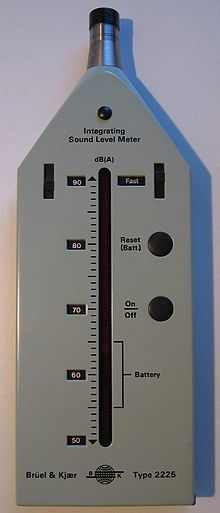Ambient noise level

In
Ambient sound levels are often measured in order to map sound conditions over a spatial regime to understand their variation with locale.
Ambient noise level is measured with a sound level meter.[4] It is usually measured in dB relative to a reference pressure of 0.00002 Pa, i.e., 20 μPa (micropascals) in SI units.[5] This is because 20 μPa is the faintest sound the human ear can detect.[5] A pascal is a newton per square meter. The centimeter-gram-second system of units, the reference sound pressure for measuring ambient noise level is 0.0002 dyn/cm2, or 0.00002 N/m2.[6] Most frequently ambient noise levels are measured using a frequency weighting filter, the most common being the A-weighting scale, such that resulting measurements are denoted dB(A), or decibels on the A-weighting scale.[4]
See also
References
- ^ "Sound and Vibration Instrument Hire and Calibration Background Noise Measurement". Gracey & Associates. Retrieved 22 October 2021.
- ISSN 2006-0459.
- .
- ^ a b "What does dBA mean when someone talks about noise levels?". Nex Flow. November 6, 2018. Retrieved 22 October 2021.
- ^ a b "Decibels & Pascals". HeartAudio. Retrieved 22 October 2021.
- ^ "PRESSURE Units Conversion micropascals to newton-per-square-meter". Justin Tools. Retrieved 22 October 2021.
![]() This article incorporates public domain material from Federal Standard 1037C. General Services Administration. Archived from the original on 2022-01-22. (in support of MIL-STD-188).
This article incorporates public domain material from Federal Standard 1037C. General Services Administration. Archived from the original on 2022-01-22. (in support of MIL-STD-188).
